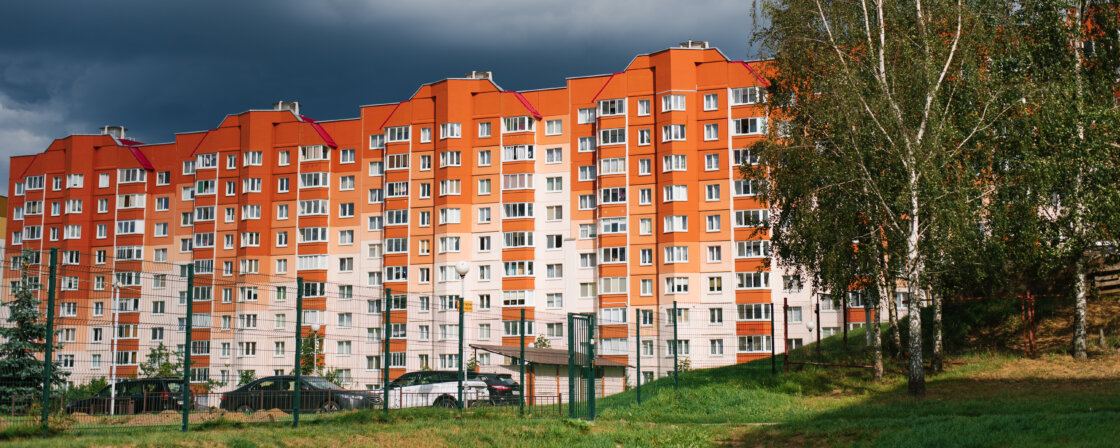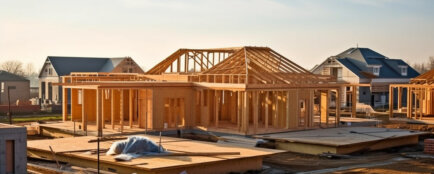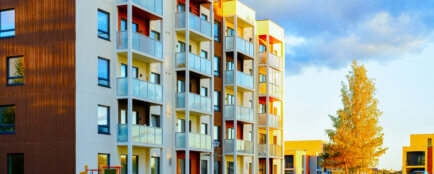The prefabricated houses and housing estates today fortunately no longer correspond to the classic socialist grey and the absence of any greenery. On the contrary, prefabricated houses are undergoing renovations, becoming more modern and colourful, and the estates themselves are getting lots of new parks and playgrounds. But how has the overall development of prefabricated houses and housing estates been going?
The history of prefabricated houses
Prefabricated houses first started to appear in our country with the development of the Bata company and the need to accommodate more and more employees. However, the real boom came after World War II, when Czechoslovakia was going through significant political changes. In 1948, the Communist Party took control and Czechoslovakia became a communist state. This was accompanied by changes in the sphere of spatial planning.
50.the 1960s and 1980s were marked by the construction of many apartment blocks to address the shortage of housing, especially in the larger cities. These buildings were called Khrushchevovka, after Nikita Khrushchev, then First Secretary of the Central Committee of the Communist Party of the Soviet Union. Many of them were built classically of brick and only a part was built of panels. They differed from later prefabs in that they had fewer floors (usually 3-5) and no elevators.
Tip for article
Tip: Wondering how to buy a mortgage-financed home? Then you must not miss our next article, in which you will learn the conditions for obtaining a mortgage. We will also advise you on how to make the right choice and what to prepare for.
Construction continued during the normalisation period, when classic multi-storey prefabricated buildings with lifts offering more spacious flats began to prevail. The well-known housing estates were also created. Some of them reached almost monstrous proportions. Examples include Prague’s Jižní Město or Brno’s Lesná. However, prefabricated buildings also found their way into the centres of many towns, for example in Benešov or Rakovník.
There are currently around 1.2 million prefabricated flats and more than two and a half million Czechs live in them. It is therefore not surprising that buying and selling them is still a hot topic. Prefabricated houses are gradually undergoing reconstruction, being insulated and given new colours. But so are the renovations of prefabricated flats – old plasterboard cores are being replaced by brick ones and socialist kitchen units are being replaced by new, more modern ones. Therefore, it is no longer a problem to buy a beautiful modern apartment in a prefabricated building. But the question remains what makes buying a prefab apartment specific and how to do it right.
Are you solving a similar problem?
Are you planning to buy a property?
We will be happy to provide you with a complete contractual and legal service related to the purchase of the property. We can do it within 48 hours, flawlessly and professionally.
I want legal service
- When you order, you know what you will get and how much it will cost.
- We handle everything online or in person at one of our 6 offices.
- We handle 8 out of 10 requests within 2 working days.
- We have specialists for every field of law.
How to buy a prefabricated apartment
If you are looking to buy a prefab apartment, you may come across a variety of options – from older prefab apartments to a modern apartment in a prefab that has been renovated. There is also a difference in whether the prefab is a freehold or a co-operative flat. Prefabs for sale are often more affordable than new builds, and if you’re lucky, you may come across a modern flat in a prefab that has been revitalised and meets today’s standards.
Buying a freehold prefab apartment
If you are looking to buy a freehold flat, the buying process will be the same as for any other property. Therefore, before the actual sale, it is necessary to check the classic requirements, such as the technical and legal condition of the apartment and the prefabricated building itself and the property conditions in the house. This means, for example, how much the monthly contribution to the unit owners’ association is and what voting rights you will get by buying the unit. In addition, find out whether the HOA or the former owner has any debts that could be passed on to you after the purchase.
Tip for article
Tip: Are you a member of the committee of a condominium or the board of directors of a housing cooperative? Do you deal with complicated legal situations with owners or members of the cooperative that you do not know how to handle? Or do you believe that someone has taken the wrong legal action against you? Arrange with us to represent you at a meeting of owners or members of a condominium association.
Buying a cooperative prefabricated apartment
In the case of a co-operative flat, you need to take into account that you are not buying the housing unit itself, but only a share in the co-operative and with it the right to rent a certain housing unit. You therefore do not become the owner of the apartment, only the tenant. The owner is always the entire cooperative. For this reason, the purchase process is very different from buying a freehold flat.
Even for a cooperative apartment, you need to check the technical and legal condition of the apartment and the panel building and find out other necessary information. In addition, however, the annuity must also be ascertained. That is, the repayment of a debt that the cooperative may have incurred, for example, during the construction or reconstruction of the house.
The biggest problem of cooperative flats is their limited financing. It is not possible to mortgage a co-operative flat and therefore you cannot take out a mortgage on it. For this reason, you need to have your own funds or choose another financing option.
When the purchase itself takes place, you do not sign a classic purchase contract, but a contract on the transfer of the cooperative share in the housing cooperative and, if necessary, a financial settlement. This makes it unnecessary to make changes to the land registry, which can speed up the whole process considerably.
Tip for article
Tip: If you are going to register your property, don’t do it alone. Contact us instead. We can help you with the drafting of the application for entry into the Land Registry so that everything is in order the first time and you don’t miss important deadlines or lose money.
Specifics of prefabricated houses and apartments
Flats in prefabricated houses have their own specifics, which are the same in most prefabricated houses and which you will not come across in other types of apartment buildings. These include:
- Specific construction material: prefabricated houses were built from large precast concrete panels. These panels were manufactured off-site and then transported to the site for assembly. The use of concrete panels allowed for a relatively quick and inexpensive construction process, which was in high demand at the time.
- Simple design: prefabricated buildings typically have a uniform and functional design. Efficiency and practicality come first, with appearance and overall impact on people second. Therefore, classic prefabs are characterised by straight lines, minimalist facades and an absence of decorative elements.
- Height and length: prefabricated houses were built in different sizes. You can find two-storey houses as well as apartment blocks with more than 20 storeys. Most often, however, prefabricated houses have 5-12 floors. It is also possible to come across different lengths and numbers of entrances. Typically there will be 3-10 entrances. Interestingly, the longest prefabricated house in our country has 18 entrances and a length of 330 metres. It can be found in Bohnice, Prague.
- Common areas. These are usually laundry rooms, bike rooms, carriage rooms, or even common rooms used for meetings of housing associations, among other things.
- The layout of the flats is very similar. They are usually 3+1 flats with two bedrooms, a small bathroom and a toilet in a plasterboard core. Kitchenettes were also designed similarly, but you won’t find them in today’s prefab apartments. Moreover, prefabricated flats are usually designed in such a way that flats located one above the other have an identical floor plan. Balconies are also usually part of each apartment.
Advantages and disadvantages of a prefabricated apartment
The advantages of a prefabricated apartment include its availability and lower price compared to new-builds. If you are looking for a prefab house for sale, you will often come across a wide range of prefab apartments that are affordable. If you are interested in a modern prefab apartment, you can choose from renovated apartments with new cores and modern kitchens. Buying and living in a prefab apartment comes with advantages and disadvantages. These are the main ones:
Advantages
- Availability and price: there are around 1.2 million prefab flats in the country. This means that it is quite easy to find a flat for sale. In addition, they tend to be more affordable compared to apartments in newer apartment buildings or, for example, “tenement” apartments, which are more likely to be found in the centre.
- Amenities. This means proximity to all amenities – there is usually a nursery and school, doctors, a shop, a post office and plenty of parking spaces a short walk from such flats. In addition, many housing estates were built as accommodation for workers in large factories. For this reason, work is usually available nearby.
- Elevator and balcony. This allows you to take advantage of the fresh air outside, grow your own vegetables or perhaps have a smoke without having to go outside. Similarly, prefab apartments have elevators. You will appreciate these especially when moving, but also if you live on a higher floor or if you have mobility problems.
Disadvantages
- Standardisation: the standardised design of prefab flats means that individual flats lack uniqueness, which can make people feel uniform. Nowadays, however, it is often possible to adapt a prefab apartment to suit your own needs, including changing its internal layout.
- Heat leakage: Concrete panels are not very thermally efficient and therefore do not insulate flats very well. Poor insulation then results in higher utility bills and unbearable heat in the summer months. However, many apartment blocks have already undergone renovations, including insulation, and can therefore offer more efficient heating and lower energy bills.
- Noise and neighbours: concrete panels conduct sound well. This means you can often hear things you’d rather not. Combine this with noisy and unhelpful neighbours and you’re setting yourself up for disaster.
Tip for article
Tip: Are you bothered by noisy neighbours and normal communication is not possible? Send them a pre-suit notice. This way, the neighbours will see that things are really getting tough (especially if you have a lawyer to back up your challenge) and you can get your way without investing time and money in court proceedings.
- Life in the housing estate: a lot of prefabricated houses are located in nice places next to nature. But there are also prefabs that are next to each other on large estates and the only view from the windows of your apartment is of the windows of the neighbouring prefabs. At the same time, the monotony and greyness of such estates can be really unpleasant.
If you decide to buy a modern apartment in a block of flats, we recommend paying attention to the condition of the block of flats in which it is located. Panel houses are undergoing renovations, which ensures that even older panel flats can be renovated into very modern and comfortable living spaces.
Summary
Prefabricated houses, known as ‘prefabs’, are a symbol of the socialist era and today are home to over two and a half million people in the country. Although in the past they suffered from a stereotypical appearance and poor quality, today they are undergoing renovation, which includes modernising flats and improving the appearance of entire estates. Buying a flat in a prefabricated building is still popular, both for privately owned and cooperative flats. The process of buying varies depending on the type of ownership, with co-operative flats not being eligible for a mortgage. Prefab flats have a specific construction and design, but now offer good affordability, making them an attractive option for many people.




